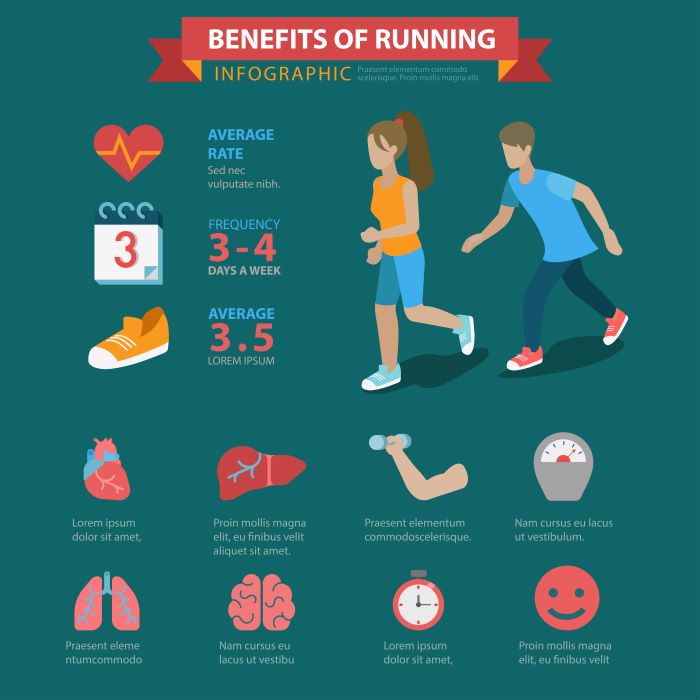Running is not just a simple aerobic activity; it’s a powerful tool that can significantly impact your health and physique. When you ask why does running slim you down, the answer lies in the complex interplay of metabolism, energy expenditure, and body composition.
Firstly, when you engage in running, your body requires a substantial amount of energy to fuel the activity. This energy is derived from the calories stored in your body. As you run, especially at higher intensities, you burn more calories, which can lead to a calorie deficit if not compensated by food intake. This calorie deficit is essential for weight loss, as it prompts the body to tap into fat reserves for energy.
Additionally, running boosts your metabolism. After a good run, your body continues to burn calories at an elevated rate, a phenomenon known as the afterburn effect or excess post-exercise oxygen consumption (EPOC). This means that the benefits of your run extend beyond the distance covered, continuing to affect your body long after you’ve finished.
Moreover, running helps in building lean muscle, especially in the lower body. Increased muscle mass can enhance your metabolic rate, allowing you to burn more calories even at rest. It’s a virtuous cycle: as you run and build muscle, your body becomes more efficient at burning fat.
To embark on this transformational journey, embrace the joy of running. Whether you’re a seasoned runner or just starting, understanding these scientific principles will help you harness running’s full potential for weight loss and fitness. Visit our website to learn more and get started today! Click here.
How Running Boosts Your Metabolism Effectively

When exploring the question of why does running slim you down, one of the key factors to consider is its profound effect on metabolism. Metabolism refers to the biochemical processes that convert food into energy, and running serves as a catalyst for these processes.
During a run, your body requires immediate energy, which it derives from stored carbohydrates and fats. As you engage in this vigorous activity, your heart rate increases, and your muscles demand more oxygen, prompting your body to work harder to deliver it. This elevated heart rate helps to increase your overall metabolic rate, making your body a more efficient calorie-burning machine.
Moreover, running not only boosts your metabolism during the activity but also contributes to a prolonged metabolic elevation post-exercise. This is known as the afterburn effect or EPOC, where your body continues to use energy to return to its resting state. Factors that influence the degree of EPOC include the intensity and duration of your run; the harder you push yourself, the greater the metabolic boost.
Incorporating interval training – alternating between high-intensity sprints and recovery periods – can also significantly enhance your metabolic rate. This method not only challenges your cardiovascular system but also elevates your oxygen consumption, further contributing to an increased metabolic rate.
Ultimately, running provides a multifaceted approach to boosting your metabolism, making it an excellent choice for those looking to lose weight and improve their overall fitness. By understanding how running interacts with your metabolism, you can optimize your workouts for maximum results.
The Role of Cardio in Slimming Down

Cardiovascular exercise, commonly known as cardio, plays a crucial role in the journey of why does running slim you down. This type of exercise elevates your heart rate and breathing, making it an effective means for burning calories and shedding excess weight.
Engaging in regular cardio workouts, such as running, cycling, or swimming, helps create a caloric deficit, which is essential for weight loss. When you burn more calories than you consume, your body begins to utilize stored fat for energy, leading to a slimmer physique over time. The efficiency of running as a cardio workout is particularly noteworthy, as it can burn more calories in a shorter amount of time compared to many other exercises.
Moreover, cardio workouts contribute to improved cardiovascular health, enhancing blood circulation and increasing lung capacity. As your fitness level improves, you may find you can run longer distances or at a higher intensity, further amplifying your calorie-burning potential.
Additionally, incorporating a variety of cardio workouts can prevent workout monotony and maintain motivation. Consider mixing in different types of cardio, such as:
- Steady-state cardio: Maintaining a consistent pace over a longer duration.
- High-Intensity Interval Training (HIIT): Short bursts of intense activity followed by recovery periods.
- Cross-training: Engaging in different forms of cardio to target various muscle groups.
In summary, the role of cardio in slimming down is integral, making it an essential component of any effective fitness regimen. By embracing cardio as a key element of your workout routine, you can accelerate your weight loss efforts and enhance your overall health.
Running vs Other Forms of Exercise for Weight Loss
When exploring the best options for weight loss, one might wonder: how does running compare to other forms of exercise? Each type of exercise offers unique benefits, but running stands out for several reasons.
First and foremost, running is incredibly efficient. A vigorous run can burn a significant number of calories in a relatively short period, often more than cycling, swimming, or weightlifting. For instance, a 155-pound person can burn approximately 372 calories in 30 minutes of running at a 10-minute mile pace, compared to 298 calories while cycling at a moderate pace for the same duration.
In addition to calorie burning, running also engages multiple muscle groups, particularly the legs, core, and even the upper body, when done correctly. This full-body engagement not only contributes to weight loss but also helps tone the body, yielding a more sculpted appearance.
Furthermore, running can be easily integrated into your daily routine. Whether it’s a quick jog around the neighborhood or a marathon training session, it requires little equipment—just a good pair of running shoes. This accessibility makes it easier for many to stick with a running program compared to other forms of exercise that may require special equipment or gym memberships.
However, it’s important to consider individual preferences and physical conditions. Some may find high-impact activities like running challenging due to joint issues, in which case low-impact options like swimming or cycling might be preferable. Incorporating a mix of exercises can also provide varying benefits, reduce the risk of injury, and prevent workout fatigue.
Ultimately, while running is a powerful tool for weight loss, the best exercise is the one you enjoy and can commit to consistently. Finding a balance that includes running, alongside other forms of exercise, will maximize your results and keep your fitness journey exciting.
Long-Term Benefits of Running for Sustainable Weight Management

Embracing running as a regular part of your fitness routine not only aids in immediate weight loss but also offers long-term benefits essential for sustainable weight management. One of the most significant advantages is the boost to your metabolism. Engaging in regular running increases your basal metabolic rate, meaning you’ll burn more calories even at rest. This metabolic boost can help counteract weight regain, making it easier to maintain a healthy weight over time.
Another benefit of long-term running is the development of lean muscle mass. As you run consistently, your body adapts by building muscle, particularly in the lower body. Increased muscle mass is crucial for weight management because muscle tissue burns more calories compared to fat tissue, even when you’re not exercising.
Moreover, running has profound effects on mental health, which can be pivotal in maintaining a healthy lifestyle. The release of endorphins during a run can improve mood, reduce stress, and combat anxiety, all of which can lead to healthier eating habits and lifestyle choices. When individuals feel good mentally, they are less likely to engage in emotional eating, a common barrier to weight management.
The social aspect of running should not be overlooked either. Joining a running group or participating in community races fosters a sense of accountability and camaraderie, encouraging you to stay committed to your fitness goals. This community support is invaluable for maintaining motivation and consistency over time.
Lastly, running can significantly enhance cardiovascular health, reducing the risk of heart disease, hypertension, and other chronic conditions. This overall improvement in health not only contributes to a better quality of life but also supports weight management efforts by encouraging a more active and engaged lifestyle.
Tips for Integrating Running into Your Fitness Routine

Integrating running into your fitness routine can seem daunting at first, but with the right strategies, it can become an enjoyable and rewarding part of your lifestyle. Here are some practical tips to help you seamlessly incorporate running into your weekly regimen:
- Start Slow: If you’re new to running, begin with a walk-run approach. Alternate between walking and running to gradually build your stamina and avoid injury.
- Set Realistic Goals: Establish achievable running goals, whether it’s a specific distance or duration. Having clear objectives can keep you motivated and focused.
- Create a Schedule: Designate specific days and times for your runs, treating them like important appointments. Consistency is key to forming a habit.
- Choose the Right Gear: Invest in a good pair of running shoes that fit well and provide the necessary support. Comfortable clothing designed for running can also enhance your experience.
- Mix It Up: Keep your running routine exciting by exploring different trails, parks, or tracks. Joining local running clubs or participating in events can introduce you to new running routes and make it more social.
- Listen to Your Body: Pay attention to how your body responds to running. Rest is crucial, so don’t hesitate to take breaks if you feel fatigued or experience pain.
Incorporating running into your fitness routine can lead to a more active and fulfilling lifestyle. Are you ready to discover the joy of running and transform your health? Visit our website to learn more and get started today! Click here.


